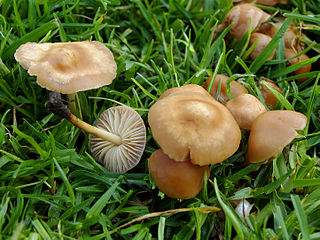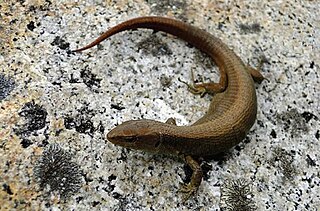
Tube-dwelling spiders (Segestriidae) is a family of araneomorph spiders first described by Eugène Simon in 1893. It consists of four genera, two large and widespread, Segestria and Ariadna, and two smaller genera, Citharoceps and Gippsicola. They are haplogyne spiders, related to the Dysderidae and placed in clade or superfamily Dysderoidea.

Pithecopus oreades is a species of frog in the family Phyllomedusidae. It is endemic to Brazil and is known from the states of Goiás and Minas Gerais as well as from the Federal District.

Marasmius oreades, also known as the fairy ring mushroom or fairy ring champignon, is a mushroom native to North America and Europe. Its common names can cause some confusion, as many other mushrooms grow in fairy rings, such as the edible Agaricus campestris and the poisonous Chlorophyllum molybdites.

Robert Whyte is an Australian writer. He was a founding co-owner and director of the Brisbane-based multimedia firm ToadShow. After 2012 he participated in the Australian Government's new species exploration program Bush Blitz. His works include The Creek in Our Back Yard: a practical guide to creek restoration (2011) and A Field Guide to Spiders of Australia for CSIRO Publishing 2017.

Eucalyptus oreades, commonly known as the Blue Mountains ash, white ash or smooth-barked mountain ash, is a species of medium-sized to tall tree that is native to eastern Australia. It has smooth, powdery whitish bark with rough bark near the base, lance-shaped to curved adult leaves, flower buds in groups of seven, white flowers and cup-shaped to cylindrical fruit.

Telopea mongaensis, commonly known as the Monga waratah or Braidwood waratah, is a shrub or small tree in the family Proteaceae. Endemic to Australia, it grows at high altitude in south eastern New South Wales, where it is often seen in moist areas at the edge of rainforest or by streams in eucalyptus forests. Growing to 6 m (20 ft) high, it has narrow green leaves 4–18 cm (1.6–7.1 in) in length, and 0.5–2 cm (0.20–0.79 in) wide. In spring bears many red flowerheads, each made up of 28 to 65 individual flowers.

Ariadna bicolor is a tube-dwelling spider. Found in North America, the spider's cephalothorax and legs are yellowish-brown and its abdomen is purplish-brown.

Telopea oreades, commonly known as the Gippsland-, mountain- or Victorian waratah, is a large shrub or small tree in the family Proteaceae. Native to southeastern Australia, it is found in wet sclerophyll forest and rainforest on rich acidic soils high in organic matter. No subspecies are recognised, though a northern isolated population hybridises extensively with the Braidwood waratah (T. mongaensis). Reaching a height of up to 19 metres, T. oreades grows with a single trunk and erect habit. It has dark green leaves with prominent veins that are 11–28 centimetres (4.3–11 in) long and 1.5–6 cm (0.6–2.4 in) wide. The red flower heads, known as inflorescences, appear in late spring. Each is composed of up to 60 individual flowers.

Matrona is a genus of damselflies in the family Calopterygidae.

Ariadna is a genus of tube-dwelling spider.
Ariadna ustulata is a species of tube-dwelling spider that is endemic to the Seychelles. It has not been recorded on Mahé since 1894, and appears to be restricted to Mont Dauban on Silhouette Island. Its adult population is estimated to be about 7,000 individuals. It is restricted to cloud forests, where it lives in mosses. It is threatened by habitat deterioration from invasive plants, especially Cinnamomum verum, and drying of cloud forests due to climate change.
Ariadna inops is a spider species in the family Segestriidae. It is endemic to Portugal.
Ariadna taprobanica is a species of spider of the genus Ariadna. It is endemic to Sri Lanka.

Mecaphesa is a genus of crab spiders that was first described by Eugène Louis Simon in 1900.
Barbara Baehr is a research scientist, entomologist, arachnologist, and spider taxonomist. She has described over 400 new spider species, mostly from Australia. She is originally from Pforzheim, Germany.
Ariadna is a genus of tube-dwelling spider.

Proctoporus oreades is a species of lizard in the family Gymnophthalmidae. It is endemic to Peru.

Cleome spinosa, called the spiny spider flower, is a species of flowering plant in the genus Cleome, native to the New World Tropics, and introduced to the United States, tropical Africa, the Indian Subcontinent, Vietnam, New Caledonia, and Korea. It is pollinated by bats.










